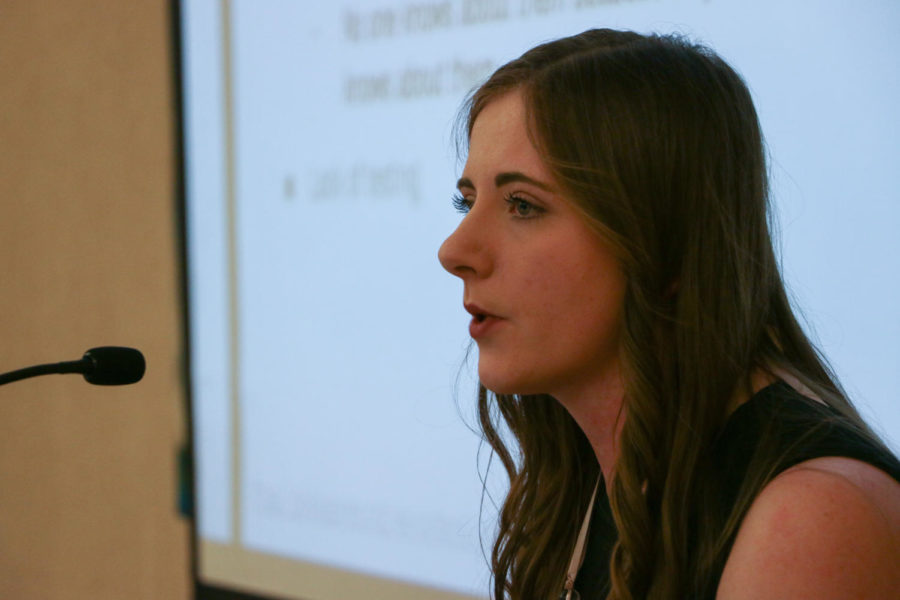Student organization raises awareness for individuals with rare diseases
Emily Blobaum/Iowa State Daily
Scarlett Eagle, now-senior in genetics, gives a speech during Rare Disease Day Feb. 28, 2018, in the Gallery Room of the Memorial Union. Eagle spoke about her experience getting diagnosed with Ehlers-Danlos Syndrome, hypermobility type and urged for an increase in awareness about rare diseases.
February 28, 2019
Iowa State’s Rare Disease Awareness Club hosted an event Thursday night for Rare Disease Day, an international day to learn about rare diseases and conditions.
In the United States, a rare disease is defined as any disease, disorder, illness or condition affecting fewer than 200,000 people in the country at any given time, according to the National Organization for Rare Disorders.
Scarlett Eagle, the president and founder of the Rare Diseases Club, opened the event. Eagle highlighted the attention the day draws to rare conditions and the vicious cycle that drives the nature of a rare disease.
“When there is relatively little information about a condition, it is often under diagnosed; when a condition is under diagnosed, it becomes neglected in the medical and scientific community,” Eagle said. “The lack of research into rare conditions contributes to the lack of knowledge about the condition, thus perpetuating the cycle.”
Eagle shared her own diagnosis experience of Ehlers-Danlos Syndrome (EDS), which was brought on by her physical therapists recognizing the symptoms from a previous patient. Without this knowledge of the existence of EDS, Eagle knows her diagnosis could have come decades later.
“There’s so many reasons why rare disease awareness is important, but to me the big thing is diagnosis; that was life changing” Eagle said. “Just having a diagnosis means that people will take you seriously.”
One in ten Americans has a rare disease, more than half being children. Following Eagle’s introduction, Dr. Stephen Elliot from Blank’s Children Hospital of Des Moines highlighted cases of rare diseases he has seen in children. Elliot projected pictures of rare cases, then explained them and their causes.
“A picture is worth 1,000 words in medicine,” Elliot said as he referred to actual pictures of cases.
After the speakers, volunteers stood by a poster that described their rare disease, and welcomed questions from event attendees. Among these volunteers were undergraduate students, graduate students and adults.
Melanie Torrie, a graduate student with Sweet’s Syndrome, shared her experience living with her rare disease. Sweet’s is a condition that affects her internally, so it is not visible from the outside. Being a disease that no one can see, Torrie said she knows it is often forgotten.
“For me, I think it’s about people having a better understanding of so called, ‘invisible disabilities,’” Torrie said.
Michael Bunney is a junior who previously suffered from musicogenic seizures. This rare form of seizure led to a brain surgery, removing a section of his brain over two years ago. Before his surgery, Bunney went undiagnosed or misdiagnosed for years.
“I haven’t had a seizure in 953 days,” Bunney said with a smile. “Today’s kind of a special day, so I counted.”
To Bunney, the connection brought by the Rare Disease Awareness Club has been comforting. He said It has given him a sense of community.
“It’s important to me because when you look around you’re connecting with people who more or less understand what it’s like to have gone through what you have, even if it’s not necessarily the same condition,” Bunney said.
The individuals with a rare disease all shared one common thought: to be represented, believed and respected. The Rare Disease Awareness Club is working to take strides to achieve these goals.
“My goal, other than to raise awareness, is to help rare disease patients to be believed and respected: that’s the first step,” Eagle said.
Editor’s note: The headline for this article has been changed from what was originally published. The Daily regrets this error and use of insensitive language.







